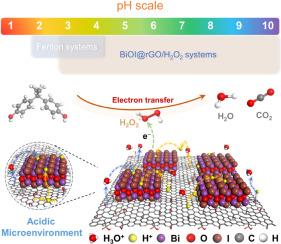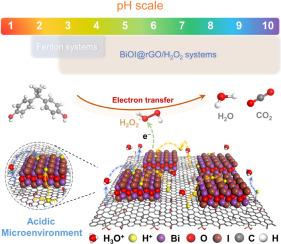扩大芬顿类反应的 pH 值范围,促进污染物降解:酸性微环境的影响
IF 12.4
1区 环境科学与生态学
Q1 ENGINEERING, ENVIRONMENTAL
引用次数: 0
摘要
异相芬顿反应为克服铁泥积累和现有均相芬顿工艺的有限可回收性提供了机会,但其反应活性在接近中性甚至更高的 pH 值条件下急剧衰减,这仍然是一个艰巨的挑战。在这项工作中,我们报告了一种多功能且稳健的方法,通过氧化石墨烯键合在 BiOI 上创建局部酸性微环境,使异质芬顿(BiOI@rGO/H2O2)系统能够在较宽的 pH 值范围(3.0-10.0)内持续降解有机污染物。值得注意的是,BiOI@rGO 在降解双酚 A 和四环素方面表现出卓越的催化活性(去除率达 100%)和持久性(超过十次循环),即使在实际废水场景中也是如此。此外,将 BiOI@rGO 固定在碳毡上以建立一个连续流动装置,可实现稳定的处理性能,在连续运行期间对微污染物的降解效率超过 98%。这项工作为在催化剂上构建酸性微环境提供了一个范例,从而克服了用于先进水净化的异相芬顿反应的 pH 限制。本文章由计算机程序翻译,如有差异,请以英文原文为准。


Expanding the pH range of Fenton-like reactions for pollutant degradation: The impact of acidic microenvironments
Heterogeneous Fenton reactions offer the opportunities to overcome iron sludge accumulation and limited recyclability of existing homogeneous Fenton process, but the sharp attenuation in their reactivity at near-neutral and even higher pH conditions, still remains a formidable challenge. In this work, we report a versatile and robust approach to create a local acidic microenvironment on BiOI with graphene oxide bonding, enabling the heterogeneous Fenton (BiOI@rGO/H2O2) system to sustainably degrade organic pollutants over a wide pH range (3.0–10.0). Notably, BiOI@rGO exhibits a superior catalytic activity (∼100 % removal) and robust durability (over ten cycles) in degrading bisphenol A and tetracycline, even in real wastewater scenarios. Furthermore, immobilizing the BiOI@rGO on carbon felt to establish a continuous flow-through device achieves a stable treatment performance with a degradation efficiency exceeding 98 % for micropollutants over a continuous operation. This work provides a paradigm for constructing an acidic microenvironment on the catalyst to surmount the pH limitations of the heterogeneous Fenton reactions for advanced water purification.
求助全文
通过发布文献求助,成功后即可免费获取论文全文。
去求助
来源期刊

Water Research
环境科学-工程:环境
CiteScore
20.80
自引率
9.40%
发文量
1307
审稿时长
38 days
期刊介绍:
Water Research, along with its open access companion journal Water Research X, serves as a platform for publishing original research papers covering various aspects of the science and technology related to the anthropogenic water cycle, water quality, and its management worldwide. The audience targeted by the journal comprises biologists, chemical engineers, chemists, civil engineers, environmental engineers, limnologists, and microbiologists. The scope of the journal include:
•Treatment processes for water and wastewaters (municipal, agricultural, industrial, and on-site treatment), including resource recovery and residuals management;
•Urban hydrology including sewer systems, stormwater management, and green infrastructure;
•Drinking water treatment and distribution;
•Potable and non-potable water reuse;
•Sanitation, public health, and risk assessment;
•Anaerobic digestion, solid and hazardous waste management, including source characterization and the effects and control of leachates and gaseous emissions;
•Contaminants (chemical, microbial, anthropogenic particles such as nanoparticles or microplastics) and related water quality sensing, monitoring, fate, and assessment;
•Anthropogenic impacts on inland, tidal, coastal and urban waters, focusing on surface and ground waters, and point and non-point sources of pollution;
•Environmental restoration, linked to surface water, groundwater and groundwater remediation;
•Analysis of the interfaces between sediments and water, and between water and atmosphere, focusing specifically on anthropogenic impacts;
•Mathematical modelling, systems analysis, machine learning, and beneficial use of big data related to the anthropogenic water cycle;
•Socio-economic, policy, and regulations studies.
 求助内容:
求助内容: 应助结果提醒方式:
应助结果提醒方式:


